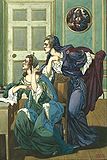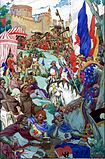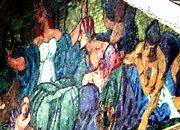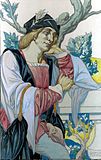Alfred Garth Jones: Difference between revisions
GarthJones (talk | contribs) |
|||
| Line 25: | Line 25: | ||
The March, 1901 edition of [[The Poster]] publication<ref name=Poster>http://www.research-design.co.uk/find_article.php?find=&page=1&what=article&asImages=text&article=32243</ref> included an article entitled "Some Remarks on the Work of Alfred Garth Jones" (by The Editor). This describes how Jones continued his training by attending the [[Slade School of Fine Art]] as a pupil of [[Frederick Brown (artist)|Professor Fred Brown]]. He then extended his studies in [[Paris]] at the [[Académie Julian]] where he was directed by [[Jean-Joseph Benjamin-Constant]] and [[Jean-Paul Laurens]], before returning to England in 1894. |
The March, 1901 edition of [[The Poster]] publication<ref name=Poster>http://www.research-design.co.uk/find_article.php?find=&page=1&what=article&asImages=text&article=32243</ref> included an article entitled "Some Remarks on the Work of Alfred Garth Jones" (by The Editor). This describes how Jones continued his training by attending the [[Slade School of Fine Art]] as a pupil of [[Frederick Brown (artist)|Professor Fred Brown]]. He then extended his studies in [[Paris]] at the [[Académie Julian]] where he was directed by [[Jean-Joseph Benjamin-Constant]] and [[Jean-Paul Laurens]], before returning to England in 1894. |
||
By the time of the [[United Kingdom Census 1901]]<ref name=UKCensus1901>United Kingdom Census 1901</ref> |
On the 15th December, 1898 Alfred married Harriette Napier Osborne (a farmer's daughter b March 1876 in [[Marden, Kent]]) at St. Luke Parish Church in [[Chelsea]], [[London]]. The ceremony was attended by Alfred's father, Thomas, and by Harriette's mother, Lydia Napier Osborne. By the time of the [[United Kingdom Census 1901]]<ref name=UKCensus1901>United Kingdom Census 1901</ref> the couple were living on the [[King's Road]], [[Chelsea, London|Chelsea]]. |
||
In 1911, Alfred and Harriette were living in [[Wandsworth]] with their 5 year old daughter, Barbara Garth Jones.<ref name=UKCensus1911 /> The census of that year records that Harriette had by this time given birth to two children. Brian Garth Jones had been born in 1902 but had died aged four. The census forms in the United Kingdom were then required to be completed by the head of the household, for that individual address, and this document bears the name and signature "Alfred Garth Jones". |
In 1911, Alfred and Harriette were living in [[Wandsworth]] with their 5 year old daughter, Barbara Garth Jones.<ref name=UKCensus1911 /> The census of that year records that Harriette had by this time given birth to two children. Brian Garth Jones had been born in 1902 but had died aged four. The census forms in the United Kingdom were then required to be completed by the head of the household, for that individual address, and this document bears the name and signature "Alfred Garth Jones". |
||
Revision as of 18:41, 13 January 2011
Alfred Garth Jones | |
|---|---|
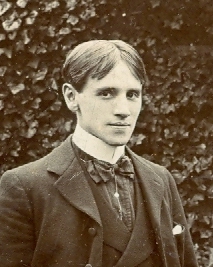 | |
| Born | Alfred Jones |
| Nationality | British |
| Occupation(s) | artist, illustrator |
| Known for | Illustration |
Alfred Garth Jones (1872 - c. 1944) was an English artist and illustrator who worked mainly in woodcut, pen and ink line art drawing and watercolour.
Early life
Alfred Jones was born in Manchester in 1872,[1] the son of Thomas Jones (b1844) and Mary McCullock (b1846). At that time, Thomas Jones was a mechanical draughtsman although he later progressed to become an Engineering Lecturer.[2]
In the United Kingdom Census 1881,[1] Alfred is listed (aged 8) with the rest of his family (Ada, Mary, Thomas, Alfred, Ernest, Robert, Maud and later Percy)[3] which was resident in Moss Side, then a Manchester suburb. At age 18, Alfred was still living with his parents and was studying art[4] in Manchester. It seems that within a few years he had moved to London in order to advance his career in the arts. This was most probably in order to become a student at the National Art Training School in South Kensington, an institution that would become the Royal College of Art in 1896.
The March, 1901 edition of The Poster publication[5] included an article entitled "Some Remarks on the Work of Alfred Garth Jones" (by The Editor). This describes how Jones continued his training by attending the Slade School of Fine Art as a pupil of Professor Fred Brown. He then extended his studies in Paris at the Académie Julian where he was directed by Jean-Joseph Benjamin-Constant and Jean-Paul Laurens, before returning to England in 1894.
On the 15th December, 1898 Alfred married Harriette Napier Osborne (a farmer's daughter b March 1876 in Marden, Kent) at St. Luke Parish Church in Chelsea, London. The ceremony was attended by Alfred's father, Thomas, and by Harriette's mother, Lydia Napier Osborne. By the time of the United Kingdom Census 1901[4] the couple were living on the King's Road, Chelsea.
In 1911, Alfred and Harriette were living in Wandsworth with their 5 year old daughter, Barbara Garth Jones.[2] The census of that year records that Harriette had by this time given birth to two children. Brian Garth Jones had been born in 1902 but had died aged four. The census forms in the United Kingdom were then required to be completed by the head of the household, for that individual address, and this document bears the name and signature "Alfred Garth Jones".
Career
Alfred adopted the middle name Garth early in his career in order to distinguish himself from artists with a similar name. The reason for choosing this name is not known, but may have been influenced by the Welsh ancestry of his forefathers. His earlier works were signed A Garth Jones (or A G J), although later this was shortened to Garth Jones.[6]
Jones' illustrations were used in several notable publications around the turn of the century, including works by Tennyson, H.G. Wells, John Milton, Conan Doyle and Carmen Sylva.
In 1894, the first examples of Jones' illustrations appeared in "Fairy Tales from Classic Myths for boys and girls" by Charles H Smith.[7]
Two years later, Jones edited The Beam, a bi-monthly magazine published by students of the National Art Training Schools. There were only three editions produced between January and May, 1896.[7]
From 1896 to nearly the end of 1899, Alfred was design master[5] at the Lambeth School of Art.
In 1898, he produced a woodcut portrayal of the bound Samson in a collection of John Milton's poems.[8]
By 1901, Jones' reputation was sufficient that he was selected, along with Harold Nelson, by Elisabeth of Wied (Queen Consort of Carol I of Romania) to illustrate the English edition of a book of verse (A Real Queen’s Fairy Book, published by George Newnes) which she had written under the nom de plume of Carmen Sylva. In France at around the same time, Jérôme Doucet (1865–1957) chose Jones to be the illustrator for his "Contes de la Fileuse" (Tales of the Spinner). Doucet was noted for the care that he took in choosing his illustrators. This book contains 117 pen-drawings by Jones so that the November, 1901 issue of The Studio[9] reported that "It has fallen to the lot of Mr. Garth Jones to be more widely known in France than he is in his own country". Also in this year, Alfred, Lord Tennyson's In Memoriam was published with illustrations by Jones.[6]
Around 1902, Jones was associated with the Carlton Studio, one of the largest studios of commercial art in London at that time. During this period, along with Albert Angus Turbayne, he was of assistance to a number of Canadian book design artists who had joined Carlton in order to improve their skills.[10]
In 1904, a mosaic portraying the Arts was designed by Jones and executed by the Bromsgrove Guild for incorporation into the pedimented gable of the new Hull School of Art, a listed building that still stands on Anlaby Road, Hull.[11]
By 1910 - 1912 Jones was again teaching at the Lambeth School of Art, where he was described as the member of staff for decorative and illuminative design. The length of this tenure is not known.

In America, his illustrations for Henry van Dyke's short stories the Half-Told Tales appeared in the January to June, 1912 issue of Scribner's Magazine.[12] In October 1912, Charles Scribner's Sons published the first edition of Van Dyke's The Unknown Quantity, with artwork by various illustrators, of which Garth Jones was one.[13] The book included Half-Told Tales and so it is likely that Jones' same illustrations and decorations were used.
Scribner’s Magazine for July to December 1925[14] showed Jones' work for an entry entitled The Two Selves by Elsa Barker (1869–1954), an American novelist and poet, born in Leicester, Vermont. However, by this time there are few other references to indicate that Jones' work was still being published, except for a few posters, such as The Bazaar for Collectors and Connoisseurs, from the 1920s.
Later life and death
Although the commercial demand for his work seems to have declined in the years after The Great War, Jones continued to produce art until the end of his life. In November, 1939 he presented a dedicated watercolour as a wedding gift to his nephew Alan (the son of his younger brother Ernest) and Alan's bride, Peggy Holt.[6] Similar paintings had already been produced to mark the marriages of each of his brother Ernest's children, as well as one for his unmarried sister Maud.[6] Other works completed for the family include a number of bookplates, all titled Ex Libris. Amongst these were plates for Ernest and other relatives, Joyce Holt, Eric Vlies and Olga Jones.[6] In some cases the original print blocks still exist. Several of his original watercolours are also retained within the family.
In 1943, Alfred wrote a letter from an address in Chadwell Heath, Essex to his brother Ernest on the subject of his nephew Philip's death in a flying accident whilst training pilots in the USA.
The exact date and location of Alfred's death are not known.
Notable illustrated works
- The Minor Poems of John Milton (George Bell & Sons, 1898).
- A Real Queen's Fairy Tales. Carmen Sylva (The Queen of Roumania) Davis and Company, Chicago, 1901.
- Front cover (Father Christmas), of The Ladies Field Magazine, Santa Claus Supplement, 30 November 1901.
- In Memoriam by Alfred, Lord Tennyson (George Newnes, 1901).
- The Hound of the Baskervilles. Arthur Conan Doyle. (London: George Newnes, 1902). Front cover design.
- The Adventures Of Sherlock Holmes by Arthur Conan Doyle. (London: George Newnes, 1901). Front cover design.
- The Diary of Samuel Pepys, Esquire, F. R. S. By Samuel Pepys. Edited by Lord Braybrooke. (London: George Newnes Ltd.; New York: Charles Scribner's Sons. 1902) Frontispiece
- The Valley of Spiders by H.G. Wells which appeared in Pearson's Magazine in March, 1903.
- The Shorter Works of Walter Savage Landor (London : George Newnes ; New York : Charles Scribner's Sons, 1904) Wood-engraved title-page compartment and illustrated endpapers by Alfred Garth Jones.
- Contes de la Fileuse and Contes de la Haute-Lisse by Jérôme Doucet [15] (Ch Tallandier, Paris)
- The Dramas and Satires of Byron (published in London by Simpkin, Marshall, Hamilton, Kent & Co., and in New York by Charles Scribner’s Sons, c1900)
- Essays of Elia by Charles Lamb (Methuen, 1920)
- I See All - The World's First Picture Encyclopedia edited by Arthur Mee (Edited at John Carpenter House, Issued by the Amalgamated Press at Fleetway House, London, c1930)
- Fairy Tales from Classic Myths for boys and girls by Charles H Smith (J. Heywood: London, 1894)
- The Poetical Works of Percy Bysshe Shelley by PERCY BYSSHE SHELLEY ; illustrated by ALFRED GARTH JONES (Simpkin, Marshall, Hamilton, Kent & Co. Ltd. 1 Jan 1920) ASIN: B0006DH5I6
- Life at the Mermaid by J. C. Squire, Collins' Clear-Type Press, London & Glasgow. circa 1920
References
- ^ a b United Kingdom Census 1881
- ^ a b United Kingdom Census 1911
- ^ United Kingdom Census 1891
- ^ a b United Kingdom Census 1901
- ^ a b http://www.research-design.co.uk/find_article.php?find=&page=1&what=article&asImages=text&article=32243
- ^ a b c d e Original work held in the Jones family
- ^ a b British Library Archives
- ^ Bodleian Library
- ^ http://www.research-design.co.uk/find.php?mode=find&publication=0&volume=&find=garth jones&in=0&time=After&year=1897&lang=&andor=0&what=page&asImages=text&page=2
- ^ http://www.gallery.ca/bulletin/num7/pantazzi2.html
- ^ http://www.britishlistedbuildings.co.uk/en-387440-humberside-university-kingston-upon-hull
- ^ scribnerstuff's photostream on Flickr
- ^ http://www.gutenberg.org/etext/30622
- ^ The FictionMags Index
- ^ http://fr.wikipedia.org/wiki/J%C3%A9r%C3%B4me_Doucet
External links
- New York Times Archives
- A Real Queen's Fairy Book
- Citizen Milton, Bodleian Library
- The Valley of Spiders
- The Lambeth School of Art
- http://special.lib.umn.edu/rare/holmes/sherlock.html
- National Art Library Catalogue
- Book Illustration and Design By Canadian Artists
- The Project Gutenberg EBook of Pen Drawing, by Charles Maginnis. Figure 62
- Gallica : Les Contes de la fileuse de Jérome Doucet, illustrations d'Alfred Garth Jones, 1900, Paris C. Taillandier
- RCA Royal College of Art Archive
-
Alfred Garth Jones The Tryst.jpg
-
Alfred Garth Jones-Samuel Pepys Diary.jpg

